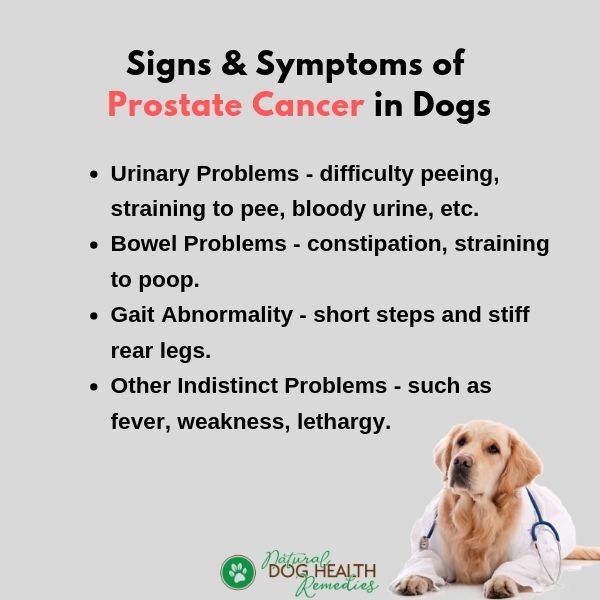Prostate Cancer in Dogs

Overview
For male dogs that are intact (not neutered), various kinds of prostate problems (e.g. prostate enlargement, prostate infections) can occur, especially when they become older.
While neutering can largely decrease the risk of developing such prostate problems as enlargement and infections in dogs, it does NOT stop dogs from developing canine prostate cancer (cancer of the prostate gland).
One study conducted by the Michigan State University Veterinary Clinical Center has found that there is no sparing effect on the risk of developing prostate cancer in dogs even when castration is done in an early age.
It appears that canine prostate cancer arises with similar frequency in neutered and intact male dogs.
Types and Causes of Prostate Cancer in Dogs
There are various types of canine prostate cancer. The most common type is carcinoma (e.g. prostatic adenocarcinoma). This type of cancer is extremely aggressive. It is also very invasive in that it can easily and rapidly spread to the lungs, lymph nodes, and bones.
In many cases, by the time the cancer is diagnosed, it is usually too advanced for successful treatment.
The cause of canine prostate cancer is not exactly clear, but some vets suspect that hormonal imbalance may be one possible cause.
Signs & Symptoms of Prostate Cancer in Dogs
Dogs with this cancer show similar signs and symptoms as those with other prostate problems, such as prostate enlargement, although for prostate enlargement, the intensity of the signs is much lower.
Watch out for these symptoms if you have a male dog, especially an older dog:
- Urination Problems: A dog with prostate cancer has difficulty urinating. He has to strain to urinate and has to urinate frequently. You may find blood in his urine. Sometimes you may also see blood or pus dripping from the dog's penis.
- Bowel Problems: A dog with prostate cancer may also suffer from constipation. Quite often, you will see the dog straining during bowel movements.
- Gait Abnormality: If a dog has prostate cancer, he will walk unnaturally. His steps are short and his rear legs are stiff.
- Other Systemic Problems: Other problems are rather indistinct, and may include fever, weakness, and lethargy.

Diagnosis of Prostate Cancer in Dogs
While the classic prostate cancer marker PSA can be tested to diagnose this cancer in people (cancer markers are molecules that are only produced by cancer cells), dogs unfortunately do not produce this marker, making diagnosing prostate cancer in dogs more difficult.
If this cancer is suspected in your dog, your veterinarian will suggest conducting initial tests such as urinalysis, x-rays and abdominal ultrasound.
The vet may also do a digital rectal examination to feel if the prostate is enlarged.
If these initial tests highly suggest cancer, a biopsy of the rectal wall is required to get a definitive diagnosis.
Treatment for Dog Prostate Cancer
 Unfortunately, treatment options are very limited for prostate cancer in dogs.
Unfortunately, treatment options are very limited for prostate cancer in dogs.
Castration usually has no effect on dogs that have prostate cancer. Removing the prostate gland by surgery is not recommended in dogs because of its location. Very often surgery can cause numerous complications (one of which is urinary incontinence).
The only option available is using chemo drugs such as Piroxicam (and occasionally radiation) to try to shrink down the tumor.
Painkilling drugs such as Tramadol and NSAIDs (e.g. Metacam) may also be prescribed to control pain and inflammation caused by the tumor.
However, chemotherapy (and radiation) is not so effective and usually fails to give the dog patient any relief of discomfort. It also does not significantly extend the patient's life.
Canine prostate cancer is rare, but when it strikes, it is a fatal disease with a very poor prognosis. Average life expectancy on diagnosis is only 6 weeks to one year.
(Read this post and all the comments on my Cancer Forum on stories of some dogs with this cancer.)

Check Out Natural Remedies for Dog Cancer
Eldredge, et al. Dog Owner's Home Veterinary Handbook 4th edition (Wiley Publishing, 2007).
M. Goldstein, The Nature of Animal Healing (Ballantine Books, 2000).
S. Messonnier, The Natural Vet's Guide to Preventing and Treating Cancer in Dogs (New World Library, 2006).





